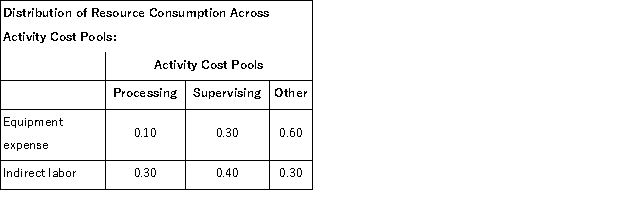Kenrick Corporation uses activity-based costing to compute product margins.In the first stage, the activity-based costing system allocates two overhead accounts-equipment expense and indirect labor-to three activity cost pools-Processing, Supervising, and Other-based on resource consumption.Data to perform these allocations appear below: 
 In the second stage, Processing costs are assigned to products using machine-hours (MHs) and Supervising costs are assigned to products using the number of batches.The costs in the Other activity cost pool are not assigned to products.Activity data for the company's two products follow:
In the second stage, Processing costs are assigned to products using machine-hours (MHs) and Supervising costs are assigned to products using the number of batches.The costs in the Other activity cost pool are not assigned to products.Activity data for the company's two products follow:  Finally, sales and direct cost data are combined with Processing and Supervising costs to determine product margins.
Finally, sales and direct cost data are combined with Processing and Supervising costs to determine product margins.  The activity rate for the Processing activity cost pool under activity-based costing is closest to:
The activity rate for the Processing activity cost pool under activity-based costing is closest to:
Definitions:
Identity
Refers to the conceptions and expressions that individuals or groups have of themselves, encompassing aspects like culture, gender, nationality, and roles.
Leader
An individual who guides or directs a group towards achieving certain goals or objectives, often by inspiring or influencing others.
Follower
An individual who supports and is guided by another person or by a group or organization.
Implicit Followership Prototype
A subconscious set of expectations about the behaviors and characteristics that define an ideal follower within a group or organizational context.
Q23: The salary of the company's president should
Q42: Beland Inc.uses a job-order costing system in
Q46: The costs of idle capacity should be
Q66: Kingsolver Corporation has provided the following data
Q68: Holdt Inc.produces and sells a single product.The
Q89: (Ignore income taxes in this problem. )The
Q90: (Ignore income taxes in this problem. )The
Q94: Stroth Corporation uses activity-based costing to compute
Q144: Rollison Corporation has two divisions: Retail Division
Q144: The Molis Corporation has the capacity to